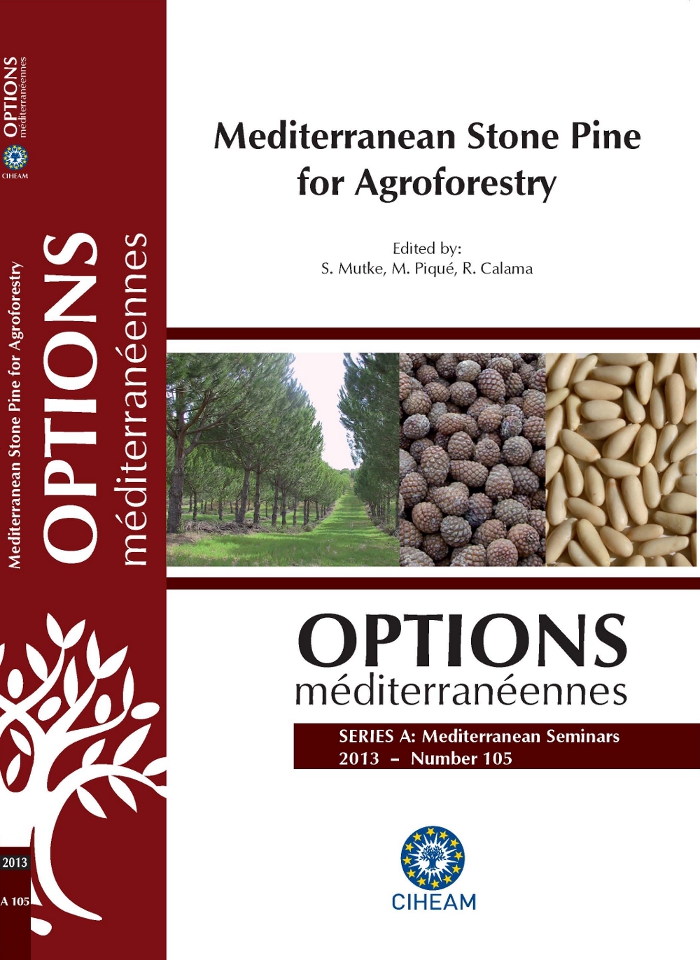| Article précédent | p. 43-47 | Article suivant |
Production and management of stone pine (Pinus pinea) for early nut production: grafted plantations as an alternative for restoring degraded areas and generating income in rural communities of Tunisia
We introduce a four years project (2008-2012), supported by the Program of Scientific Cooperation and Interuniversity Research (PCI), funded by the Spanish Agency for International Development Cooperation (AECID), and implemented in Tunisia and Spain. The objective of the project was to establish a systematic methodology for producing grafted plant using two types of stock: Pinus pinea and Pinus halepensis, from known provenances from Spain and Tunisia and to implement field trials in both countries, on different hydric and edaphic conditions, for evaluating the development of the plantations. Due to Pinus pinea interest for nut production, grafted Pinus pinea plantations for early and abundant cone yield can be an interesting alternative for restoring and revalorize some Mediterranean areas, generating both economic and ecological benefits (soil protection).
Nous présentons ici un projet quadriennal (2008-2012), mené avec l'appui du Programme de Coopération Interuniversitaire et de Recherche Scientifique (PCI), financé par l'Agence Espagnole pour la Coopération Internationale au Développement (AECID), et mis en place en Tunisie et en Espagne. L'objectif de ce projet était d'établir une méthodologie systématique pour produire des plants greffés en utilisant deux types de porte-greffe : Pinus pinea et Pinus halepensis, de provenances connues d'Espagne et de Tunisie, et de mettre en place des essais de terrain dans ces deux pays, sous différentes conditions hydriques et édaphiques, afin d'évaluer le développement des plantations. Dû à l'intérêt de Pinus pinea pour la production de pignons, les plantations greffées de Pinus pinea pour une production précoce et abondante de cônes peuvent constituer une alternative intéressante afin de restaurer et de revaloriser certaines zones méditerranéennes, créant ainsi des bénéfices autant économiques qu'écologiques (protection du sol).
- [ Afficher ]
- [ Télécharger ]
- [ Exporter la citation ]
Vous pouvez télécharger la citation au format :
- [ Imprimer ]
-
Mots-clés
AGROFORESTERIE, COOPERATION INTERNATIONALE, ESPAGNE, PEPINIERE, PINUS HALEPENSIS, PINUS PINEA, PLANTATION FORESTIERE, PORTE GREFFE, TUNISIE, CONECiter cet article
Piqué M., Ammari Y., Solano D., Aletà N., Bono D., Sghaier T., Garchi S., Coello J., Coll L., Mutke S. Production and management of stone pine (Pinus pinea) for early nut production: grafted plantations as an alternative for restoring degraded areas and generating income in rural communities of Tunisia. In : Mutke S. (ed.), Piqué M. (ed.), Calama R. (ed.). Mediterranean stone pine for agroforestry. Zaragoza : CIHEAM / FAO / INIA / IRTA / CESEFOR / CTFC, 2013. p. 43-47. (Options Méditerranéennes : Série A. Séminaires Méditerranéens; n. 105). AGROPINE 2011 International Meeting on Mediterranean Stone Pine for Agroforestery, 2011/11/17-19, Valladolid (Spain). http://om.ciheam.org/om/pdf/a105/00006780.pdf



